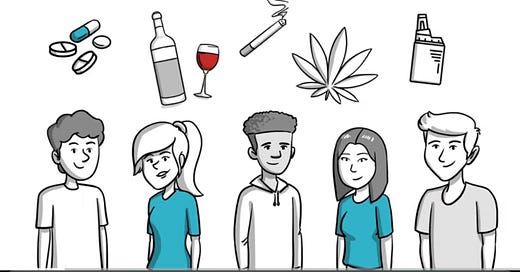Research revels adolescent drug use continued to fall in 2024, extending the historically large decreases during the pandemic onset in 2020.
University of Michigan Institute for Social Research’s Monitoring the Future has continuously been studying American adolescent, ages 10-19, behaviors, attitudes, and values since 1975. Each year over 25,000 8th, 10th and 12th grade students and approximately 20,000 adults ages 19 to 65 are surveyed through funding from the National Institute on Drug Abuse.
Lead investigator Richard Miech commented on the surprising results:
“I expected adolescent drug use would rebound at least partially after the large declines that took place during the pandemic onset in 2020, which were among the largest ever recorded.”
The results continue to be in contradiction to the vast majority of education experts that anticipated a drug use would rapidly recover after social distancing restrictions were lifted.
But Miech’s team found that the number of 8th, 10th,and 12th grade students across the America in 2024 who abstained over the last 30-days from alcohol, marijuana or nicotine cigarettes or e-cigarettes (which are the three most common forms of substance use by adolescents} reached record levels in 2024.
Student percentages in 2024 by grade that abstained from these drugs equaled 67% of 12th graders(compared to 53% in 2017 when it was first measured), 80% of 10th grade (compared to 69% in 2017) and 90% of 8th graders (compared to 87% in 2017).
Increases in abstentions from 2023 to 2024 were very significant in the 12th and 10th graders surveyed. Declines in drug use in 2024 were evident across alcohol, marijuana and nicotine vaping:
• In 2024, 42% of 12th graders reported using alcohol in the past 12 months, a substantial drop from 75% in 1997. Among 10th graders, the percentage fell to 26% from 65% in 1997; among eighth graders, it dropped to 13% from 46% in 1997.
• Marijuana decreased in use among all three grades. The percentage who used marijuana in the past 12 months hovered within a tight window of just a few percentage points from 2000 to 2020, but in 2021, the first year after the pandemic onset, substantial declines in marijuana use took place in all three grades. The past 12-month use levels in were the lowest in the past three decades, at 26% for 12th graders, 16% for 10thgraders, and 7% for 8th graders.
• For nicotine vaping, the 2024 declines continue a 180-degree turn centered around the pandemic onset. Before the pandemic, use levels surged from 2017 to 2019 and then held steady in 2020 (before the pandemic onset). Large declines took place during the pandemic, and these declines have since continued to the point where the 2024 levels for the past 12 months of nicotine vaping are close to where they started in 2017, the first year that questions on nicotine vaping were included on the survey. Specifically, past 12-month use was 21% in 12th grade (compared to 35% in 2020 and 19% in 2017), 15% in 10th grade (compared to 31% in 2020 and 16% in 2017) and 10% in eighth grade (compared to 17% in 2020 and 10% in 2017).
Miech perceives that continued declines in adolescent drug use suggest that a delay in drug use initiation during adolescence could potentially lower substance use trajectories over a lifetime.
Such a delay, he says, may prevent youth from associating with drug-using peer groups that encourage continued use and may forestall biological processes that contribute to the development of addiction.




